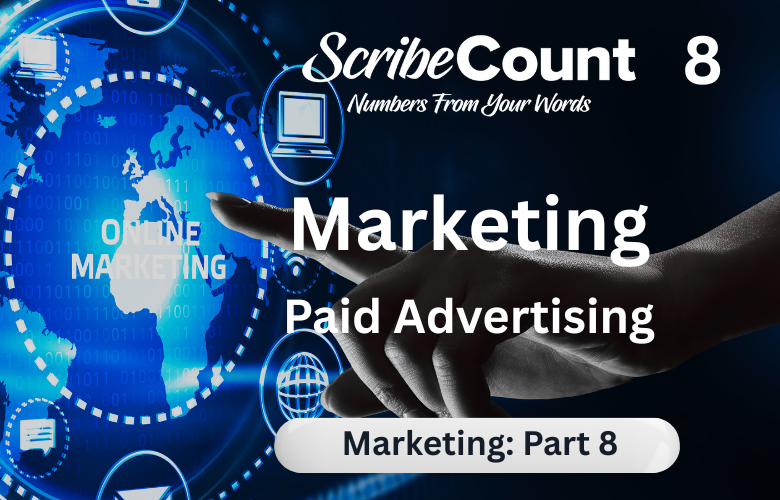Paid Advertising for Indie Authors
In the ever-evolving landscape of indie publishing, few tools offer the same scale, precision, and potential impact as paid advertising. While email lists, newsletter swaps, and organic content remain essential, paid ads give indie authors the power to place their books in front of exactly the right readers, at exactly the right time. Whether the goal is to drive sales, grow a mailing list, increase audiobook listens, or build long-term brand awareness, paid advertising has become a foundational pillar of many successful author careers.
What sets paid advertising apart is its scalability and control. Authors no longer need to rely solely on word-of-mouth, platform algorithms, or curated promotional sites. With paid ads, they can target readers directly—by genre, interest, behavior, location, and even purchasing history. But advertising also comes with challenges. It requires knowledge, experimentation, budget discipline, and an understanding of core business metrics like ROI (Return on Investment) and ROAS (Return on Ad Spend).
This article provides a comprehensive overview of paid advertising for indie authors. It will define what paid advertising is and how authors use it across ebook, print, and audio formats. It will walk through the top five advertising platforms used by authors, explore their strengths and limitations, and provide insights into strategy, cost, targeting, and tracking. It will also show how paid ads can be used in combination with other promotions to amplify results and build a sustainable author business.
What Is Paid Advertising for Indie Authors?
Paid advertising is the practice of spending money to display promotional content—such as book covers, blurbs, sales copy, or videos—to a targeted audience through a digital platform. For indie authors, this means placing ads on websites, apps, and social networks where book buyers are already active, with the goal of increasing sales, driving traffic, or collecting reader emails.
Unlike free promotional tactics like social media posting or newsletter swaps, paid ads guarantee exposure. Authors pay for impressions (views), clicks (traffic), or conversions (sales or sign-ups), depending on the ad platform and campaign structure. Ads can appear on search result pages, reader apps, competitor product pages, news feeds, and even inside ebook devices.
Paid ads are most often used for ebook promotion, but they also work for audiobooks and print—especially when linked to wide platforms like Apple, Barnes & Noble, Kobo, or direct sales stores like Shopify and Payhip. When used strategically, they can launch new titles, boost series read-through, scale backlist sales, or grow a direct fanbase through lead generation.
The Top Five Advertising Platforms for Indie Authors
While new platforms emerge regularly, five stand out as the most widely used, accessible, and impactful for indie authors: Amazon Ads, Facebook/Meta Ads, BookBub Ads, TikTok Ads, and Google Ads. Each offers a different audience, pricing model, and learning curve—and each serves a distinct role within an author’s marketing ecosystem.
Amazon Ads
Amazon Ads are native to the Kindle Direct Publishing platform and represent the most widely used ad system in indie publishing. Ads appear directly within the Amazon marketplace—on search result pages, product pages, and Kindle e-readers—making them particularly powerful for ebook discovery.
Because readers on Amazon are already in a shopping mindset, conversion rates tend to be higher than on most other platforms. Authors can target keywords, product categories, ASINs (individual book pages), and auto audiences. Amazon Ads can promote ebooks, print editions, and even audiobooks through linked product pages.
The downside is complexity. The platform requires careful bid management, keyword research, and frequent optimization. Tools like Publisher Rocket and ScribeCount help authors navigate performance metrics and profitability tracking. Budgets can range from $5 per day to thousands, and it often takes several weeks of testing before a campaign becomes profitable.
Facebook/Meta Ads
Meta Ads—which cover both Facebook and Instagram—offer unmatched audience targeting. Authors can build custom audiences based on reader interests, behaviors, email engagement, or website visits. Ads can promote anything: free downloads, direct store pages, lead magnets, book launches, and more.
Facebook excels at building email lists through lead ads and driving traffic to direct sales platforms. It’s particularly effective for authors selling wide, offering reader magnets, or launching new series. Ads can include images, carousels, video, and dynamic content.
The platform’s power comes with a learning curve. The ad manager interface is complex, creative testing is essential, and approval policies can be unpredictable. Authors must also set up the Meta Pixel for proper conversion tracking. Budget minimums start around $5 per day, though meaningful campaigns often require $300–$1,000 monthly.
Authors who master Meta Ads can build powerful direct-to-reader ecosystems, selling print, ebooks, and audio without relying on retailers.
BookBub Ads
BookBub Ads are display ads that run on the BookBub platform, which has over 20 million readers across the U.S., U.K., Canada, and Australia. Unlike curated Featured Deals, BookBub Ads are self-serve and appear in daily reader emails and on author profile pages.
Authors can target readers by author interest (i.e., fans of similar writers), genre, device, or region. Ads run on a CPM or CPC basis, meaning authors pay for impressions or clicks. The ad creative includes a cover image, headline, and call-to-action.
BookBub Ads excel in targeting high-quality, purchase-ready readers. They’re ideal for series starters, price drops, international promotions, or new launches. They pair especially well with Chirp for audiobook deals and with Written Word Media promos to reinforce visibility.
Budgets are flexible, but competition is high in saturated genres. Authors should plan to A/B test several creatives and target combinations to find the sweet spot. Many use the platform to scale promotions that are already working elsewhere.
TikTok Ads
TikTok Ads are a rising star in book marketing, particularly for genres with strong BookTok presence like romance, fantasy, and young adult. Ads appear between user videos and can drive traffic to retailer pages, author websites, or email sign-ups.
The platform is ideal for authors with visual storytelling skills or strong cover art. Video ads range from polished trailers to organic-style clips. TikTok offers broad interest-based targeting and allows authors to retarget website visitors or email subscribers.
Authors can start with a modest budget—$20 to $100 per day—though ad performance varies widely. TikTok’s creative-first culture means that success depends heavily on storytelling, trends, and timing. Tools like Canva and CapCut can help authors produce fast, engaging content.
Used strategically, TikTok Ads can build awareness, drive viral momentum, or support direct sales efforts alongside newsletter swaps or influencer campaigns.
Google Ads
Google Ads remain one of the most versatile advertising systems available. Authors can run search ads, display ads, and even YouTube video ads targeting book buyers across Google’s massive ad network.
Search ads are text-based and appear when users search for specific keywords. Display ads show banners on partner websites. Video ads run on YouTube. Authors can target keywords, websites, interests, and demographics.
Google Ads are effective for promoting wide distribution, audiobooks, and nonfiction. They also support direct store traffic, course sales, and list-building. Setup involves integrating conversion tracking through Google Tag Manager or Shopify apps.
The downside is complexity. Google’s dashboard is data-rich but intimidating. It’s best suited for authors with strong landing pages, clear brand messaging, and the patience to optimize over time.
Budgets start low but can scale significantly depending on goals. Many authors use Google Ads to supplement their paid newsletter strategy or to target readers searching for comparable books.
Pros and Cons of Paid Advertising
Paid ads give authors control over reach, timing, and targeting. They’re scalable and measurable, allowing for rapid testing and refinement. They can create immediate visibility for new releases or revive slow backlist titles. And when used with email marketing and direct sales, they support full-funnel audience building.
However, paid ads also involve risk. They require time to learn, money to test, and persistence to optimize. Poor creative, irrelevant targeting, or weak product-market fit can waste budget. There’s also fatigue—running ads year-round demands strategic rest periods or creative refreshes to avoid declining returns.
Authors who thrive with paid ads treat them like a business tool. They track performance, refine offers, and diversify campaigns to avoid overdependence on a single platform.
Costs, Requirements, and Prerequisites
Advertising costs vary by platform and genre. Some niches, like thrillers or romance, are highly competitive and command higher click prices. Others, like nonfiction or niche fantasy, may offer lower costs but fewer clicks.
To advertise successfully, authors need professional book covers, tight metadata, compelling blurbs, and a clear call to action. A weak product will not convert, regardless of ad budget.
Direct sales authors need functional stores, working delivery systems (like BookFunnel or SendOwl), and email opt-ins. Retailer-based authors must ensure their product pages are optimized with reviews, keywords, and series links.
Expect to invest $100–$300 monthly for early testing. Larger campaigns (especially launches) may require $500–$1,000. Platforms like ScribeCount help authors analyze revenue across all platforms to ensure profitability.
Understanding ROI and ROAS in Author Advertising
Two essential metrics for paid ads are ROI (Return on Investment) and ROAS (Return on Ad Spend). Both help authors determine whether their ad campaigns are delivering profitable results.
ROI measures total return relative to total investment. For example, if you spend $200 on ads and earn $600 in royalties and sales, your ROI is 200%—you’ve tripled your money.
ROAS focuses only on the advertising spend itself. If you spend $100 and generate $300 in tracked revenue from that campaign, your ROAS is 3.0—every dollar spent generated three dollars in return.
High-performing authors track both. ROAS helps evaluate individual campaigns, while ROI helps evaluate your business as a whole. Tools like ScribeCount, BookReport, or AuthorAnalytics allow detailed revenue tracking by format, vendor, and timeframe.
To measure accurately, authors should also track read-through across series, email opt-in value, and long-tail sales. A $100 ad that drives 50 free downloads may not pay off today—but if 30% of those readers buy Book 2 at full price, the lifetime ROAS could be significant.
Combining Paid Ads with Other Promotions
The most successful indie authors integrate paid advertising with broader promotional campaigns. For example, a launch plan might include:
- Amazon Ads targeting category and keyword traffic
- Meta Ads promoting a reader magnet or preorder
- A BookBub Ad reinforcing a newsletter promo on Freebooksy
- A TikTok video teasing the book’s premise
- Newsletter swaps to expand list size
- Direct sales funnels built with Shopify or Payhip
This multi-channel approach reduces risk and improves performance. Paid ads amplify visibility, while other tools increase conversion. Email marketing, in particular, multiplies the value of each ad click by building long-term reader relationships.
Authors also time ads around BookBub Featured Deals, Written Word Media promos, or retailer sales events like Kindle Countdown Deals. Coordinated ad spend during high-interest periods yields stronger results than random daily spending.
Final Thoughts: Advertising as Investment, Not Gamble
Paid advertising isn’t a silver bullet—but it is a powerful tool when treated with discipline, strategy, and patience. For indie authors willing to learn the systems and track their performance, ads unlock scale that organic marketing alone cannot achieve.
Whether you’re launching a new book, growing an email list, selling direct, or reawakening a dormant series, paid ads offer targeted reach and measurable impact. But they must be built on strong foundations: great writing, strong branding, and clarity about your goals and audience.
With consistent testing, cross-platform campaigns, and reliable data from tools like ScribeCount, you can turn advertising from an expense into an investment—one that powers your author business for years to come.

